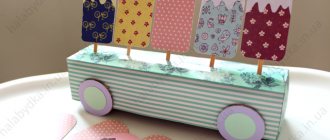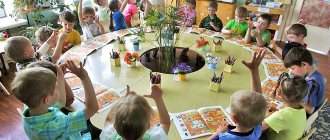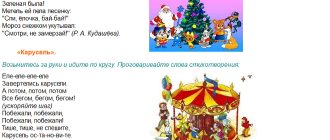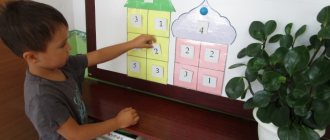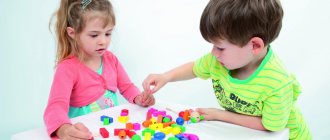Ecological games
on the development and formation of a correct attitude towards the surrounding nature contain a plot, use roles, rules, or contain only tasks. Actions in such games can be indicated by text, which determines the sequence of the game.
The games proposed by preschool teachers will help preschoolers love their native land and the surrounding animate and inanimate nature. Game exercises and manuals developed by preschool education specialists are easy to make and have one or more options for implementation.
Games and aids for environmental development and education
Contained in sections:
- Didactic games 32101
- Nature, ecology. Games, teaching aids 912
- Ecology for children. Ecolates, nature defenders 4173
Includes sections:
- Seasons, months, weeks. Games and teaching aids 1198
- Weather and nature calendar 241
- Sorting garbage and waste. Games, teaching aids 44
- Ecological signs. Rules of behavior in nature, in the forest 23
- Ecological lapbooks 249
By groups:
- Senior group
- Preparatory group
Showing publications 1-10 of 79. All sections | Ecology, nature protection. Didactic games and manuals
New
Photo
The best
Didactic game “Remove garbage - save nature”
Purpose of the game : to help students familiarize themselves with the concepts of “waste sorting”
,
"recycling"
. Objectives: Develop the ability to classify objects according to the materials from which they are made. Develop logical thinking, observation, memory, attention, fine...
The use of psychological games in preschool educational institutions for the development of emotional intelligence of preschool children. Game "Dangers of the Magic Forest"
"The Dangers of the Magic Forest"
Author: Khukhlaeva O.V.
PURPOSE OF THE GAME AND OBJECTIVES The goal is to correct various fears in preschool children. It is possible to use the game to reduce emotional stress in children during the adaptation period. Objectives: — creating a relaxed atmosphere;…
Organization of work on environmental education of preschool children in everyday life
Work on environmental education includes the formation of the foundations of reasonable interaction between humans and nature, including the competent use of natural resources.
1.3. Organization of work on environmental education of preschool children in everyday life
Environmental education involves solving three interrelated tasks (improving the qualifications of teachers; environmental education of children; promoting environmental knowledge among parents, who in rural areas have a pronounced specificity, due, on the one hand, to the proximity of natural objects, and on the other hand, to the fact that life , and people’s work activities are directly related to natural resources. Kindergarten students should have the opportunity to observe plants and animals not only in specially organized classes, but also in the course of everyday life. It is also important that they are constantly among adults who are engaged in agricultural work , and not only know from their conversations, but also see with their own eyes how bread is grown, etc.
When starting environmental education of preschoolers, we set ourselves the following tasks:
1. To form ideas about natural nature, independent of man from his activities, and cultural nature, created and supported by human labor.
2. To give an understanding that any object of living nature exists only for now; for this there are necessary conditions, the violation of which leads to its death and disappearance, sometimes forever.
3. Show how a person uses cultural nature (growing and harvesting grain, vegetables, fruits, producing domestic animals, flowers, etc.).
4. Demonstrate how a person uses the gifts of wild nature (picks mushrooms and berries, enjoys the beauty of nature), and convinces of the vital need for a reasonable, and therefore caring, attitude towards it.
5. Form the idea that in nature everything is interconnected, like in a chain, all the links that need each other and without each other can simply cease to exist.
Important aspects of environmental education are also:
- development of a humane attitude towards nature, based on the perception of it as a living and aesthetically beautiful whole;
- fostering a willingness to work in nature with joy (planting and watering plants, caring for animals) and joyfully coming to the aid of everyone in need.
How is a conscious and humane attitude towards nature formed? First of all, through observation and work in nature, which allows one to accumulate certain knowledge and apply it in practical activities.
A large role in working with children is given to corners of nature (an aquarium with fish, birds in cages, a hamster), which are available in each group.
In the senior and preparatory groups for school, the main task of daily observations of the inhabitants of the aquarium and classes is to deepen lessons about the conditions of their life, to consolidate the understanding that people create the conditions necessary for the life of aquarium fish. Working from a specially prepared display table, children in the older group name what is depicted on it (fish, an aquarium, a person, cans of food , etc.); children in the school preparatory group explain the essence of the depicted arrows (leading questions: “Why are the arrows from the fish directed towards the aquarium? Why are the arrows from the person directed towards the aquarium? Who takes care of the aquarium fish?)
Similar work is carried out to familiarize children with birds that live in a corner of nature (the appearance of birds; the characteristics of their behavior; the conditions necessary for their full life in captivity, what a person can and should do for them). This work is combined with observations of chicks living in the kindergarten area, in the forest, and in the field. Particular importance should be attached to winter feeding of birds .
Feeders can be of various designs, which are made by the pupils themselves and their parents.
Feeders are located away from playgrounds so that the noise does not interfere with the birds pecking at food. Children of the senior and preparatory groups, together with the teacher, or cook on their own (collect bread crumbs, add seeds and herbs harvested in the summer). Winter feeding of birds makes it possible to observe them: children in the older group learn to distinguish between wintering and migratory birds, and in the preparatory group they learn how birds fly (“open” their wings and tail when taking off, folding them when landing). After observing birds in the kindergarten area, students must be given tasks. Children of the senior and preparatory groups for school during drawing classes perform collective drawings on the proposed topic (“Birds in Winter”) with birds in the process of everyday life, in a corner of nature and on the site, which ends with an activity in which the knowledge acquired by the children is substantiated and systematized. The purpose of the lesson is to clarify ideas about wintering princes and the peculiarities of their life in winter; show the need for winter feeding (in the older group); bring to the understanding that a person, by feeding birds in winter, saves them from death; to form ideas about the differences in the life of birds in captivity and in the wild and about the adaptation of birds to flight (in the preparatory group for school). Observations are carried out with children in the senior and preparatory school groups based on comparisons of different plants. Children will learn about the conditions that plants need and help care for them. Children's attention is drawn to the fact that plants need light (that's why they stand on the windowsill), as well as to how different indoor plants and trees and shrubs outside the window look in winter. This is how children learn that, in addition to water, earth, light, plants need warmth. Children of the senior and preparatory school groups also plant flowers and germinate seeds. The purpose of classes in these groups is to develop a desire to take care of indoor plants , to practice the skills of sowing seeds and caring for them, to consolidate ideas about what is necessary for germinating seeds; test existing knowledge in practice.
Another form of work used is to familiarize children with the agricultural work of adults, for which excursions are organized for older preschoolers to livestock and dairy farms and in greenhouses. Children's attention is focused first on animals, their behavior, conditions and features of keeping (mechanization of labor - feed dispensing machines, automatic milking of cows), then on the work of milkmaids, cattlemen, veterinarians, and on the sequence of their actions with gentle treatment of animals. After visiting the farm, we organize classes and conversations with looking at relevant pictures and reading stories to clarify and consolidate the children’s ideas about domestic animals. This work ends with special classes, the purpose of which is to show that domestic animals are dependent on humans; to form a generalized idea of domestic animals based on the following characteristics: they live together with people, are not afraid of them, are used on the farm, people take care of them; teach to understand and explain why this or that animal is considered a domestic animal.
In the environmental education of preschoolers, it is necessary to actively use all the opportunities that summer provides. The most important thing that can be done is to explain that everything in nature is interconnected, using the example of the simplest and most familiar natural objects to children (including “butterfly flowers”: if you destroy all the flowers, the butterflies will have nothing to eat and they will die ; therefore, we go to the forest to visit good friends - to communicate with its inhabitants and admire, enjoy the beauty of nature). In the process of observing birds and insects in the forest and field, children begin to understand that:
- wild nature is adapted to independent (without human intervention) life (swallows fly very quickly - it is difficult for cinchona birds to keep up with them, they catch insects that feed right in the air, etc.);
— the task of man is not to destroy this holistic and harmonious world by gross intrusion into the lives of its inhabitants; protect them to the best of your ability (feed birds, protect anthills, plant forests, etc.);
- people in our time, in the process of active economic activity, often negatively affect the habitat of all living things, including their own (they pollute the atmosphere, litter water bodies, cut down forests, etc.).
Environmental education of children must be carried out together with the family: individual consultations , round table discussions, business games “What? Where? When?"
, competitions for nature experts; show parents fragments of classes, evenings of entertainment, holidays, filmed on videotapes.
The most important condition for the successful implementation of an integrated approach is the creation of an environment in which adults, by personal example, demonstrate to children the correct attitude towards nature and actively, to the best of their ability, participate together with children in environmental activities.
The immediate natural environment - a corner or room of nature, a winter garden or microfarm, a kindergarten site - allows you to organize systematic observation of plants and animals, and introduce children to the regular work of caring for them. Constant communication with animals on the territory of the preschool institution, growing flowers and vegetables. Feeding birds in winter is a necessary condition for all living things, the conditions under which clear ideas are formed about the relationship of plants and animals with the external environment, about human environmental activities.
The most “ecological” object of a preschool institution is an aquarium with fish. A properly designed, selected and stocked aquarium is a model of a natural reservoir, a microecosystem in which all components - water, lighting, plants, animals - are in the right proportion and create ecological balance. The larger the aquarium, the faster the ecological balance is created in it, the easier it is to maintain. In a large volume of water, fish continue to grow and reach large sizes. Equilibrium in the aquarium is created and maintained for a long time only if a number of rules are observed:
1. The best place for an aquarium is near the wall, perpendicular to the window.
2. The aquarium with water cannot be moved.
3. The purity of water and the health of fish largely depend on the soil. The best soil: coarse sand or small pebbles.
4. The aquarium is filled with clean, settled water at room temperature.
5. Cover the top of the aquarium tightly with glass.
6. Lighting is an essential component for establishing ecological balance in an aquarium.
7. The aquarium is settled 3-7 days after its preparation is completed.
A properly charged and populated aquarium , in which the complexity of the balance between all its components is a beautiful spectacle of a harmoniously developed ecosystem in which all living creatures that make up it feel good.
Adults should understand that children’s often careless and sometimes harsh attitude towards nature is explained by their lack of necessary knowledge. That is why the education of empathy and compassion occurs in inextricable unity with the formation of a system of environmental knowledge accessible to preschoolers, which includes:
1. The idea of plants and animals as unique and unrepeatable living beings, their needs and ways to satisfy these needs.
2. Understanding the relationship between living beings and their habitat, the adaptability of plants and animals to living conditions.
3. The awareness that all living beings on Earth are connected to each other by a complex system of connections (everyone needs each other, everyone depends on each other, the disappearance of any link breaks the chain, i.e. biological balance) and at the same time each of them has its own ecological niche, and all of them can exist simultaneously.
Of course, knowledge alone is not enough to form in children a humane attitude towards nature - it is necessary to include it in practical activities feasible for their age, for which in preschool institutions conditions should be created for constant and full communication of children with living nature (for example, a teacher together with children can plant a corner of nature, take care of its inhabitants, plant a flower garden, etc., which, naturally, depends on the capabilities of the preschool institution). And creating and maintaining a positive emotional state for children (joy from a job well done that has been praised by the teacher, a blooming flower, a recovering puppy) contributes to the further development of feelings of compassion and empathy. An active humane attitude towards nature and awareness of the aesthetic value of natural objects, which is why the education of aesthetic feelings is one of the necessary conditions for environmental education, which includes a love of nature.
The main thing is to always remember: before teaching children to see beauty and understand the essence of beauty as an aesthetic category, it is necessary to develop the emotional sphere, because the feelings of preschoolers are not yet stable and deep enough, they are selective (“I like this, but I don’t like that”) and subjective ( for example, I like a hare because it is fluffy and active, but I don’t like a hedgehog because it has a prickly character.
In addition, it is on walks and excursions that children can be taught to understand the impact of human activity on nature: environmental measures and the consequences of immoral influence (air and water pollution, deforestation, destruction of gardens, etc.). The teacher’s task is to bring children to the understanding that all of us together and each of us individually are responsible for the Earth and everyone can preserve and increase its beauty.
So, in the course of studying psychological and pedagogical sources, we determined that only a combination of specially organized forms and work in everyday life will lead to the ecological development of the child’s personality.
It is at the stage of preschool childhood that the child receives emotional impressions about nature, accumulates ideas about different forms of life, i.e. the fundamental principles of ecological thinking are formed in him, the initial elements of ecological culture are laid in his consciousness. The main evidence regulating the content of the pedagogical process in preschool educational institutions is training and education programs that provide one or more areas of education and development; Among the latter there are many environmental ones.
Classes are the main form of organizing children in kindergarten. At each lesson, general didactic tasks are solved under the guidance of the teacher, the ability to learn, develop, intellectual and creative activity is formed.
Kindergarten students have the opportunity to observe plants and animals not only in specially organized classes, but also in the process of everyday life. It is also important that they are constantly among adults who are engaged in agricultural work, and not only know from conversations, but also see with their own eyes how they grow bread, care for animals, etc.
The teacher’s task is to bring children to a reminder that we are all and each of us individually is responsible for the Earth and everyone can preserve and increase its beauty.
Thus, work on environmental education of preschool children should be carried out in a system in close connection with classes and other forms of work used in everyday life.
See the thesis “ Environmental education of preschool children in the classroom and in everyday life ”
